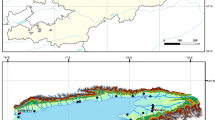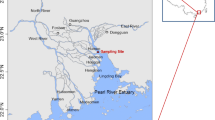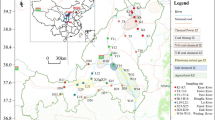Abstract
Cenotes are naturally occurring flooded caves that are frequent in Mexico’s Yucatan Peninsula; they result from the collapse of limestone bedrock into the regional groundwater table. Cenotes in Quintana Roo are important ecological and economic hot spots but are susceptible to anthropogenic pollution. In this study, we collected water samples from 11 cenotes over multiple years to evaluate polycyclic aromatic hydrocarbon (PAH) concentrations and patterns as associated with tourist traffic. The primary PAHs detected in samples included fluoranthene, anthracene, phenanthrene and naphthalene, with total PAH concentrations increasing almost fivefold for cenotes sampled from 2016 to 2017. This is compared to only a 7% increase in tourist traffic during these years. Multivariate statistical analysis of the PAH concentration data suggests that diesel, gasoline and asphalt are the most likely pollution sources and that they are associated with periods of increased tourist traffic.



Similar content being viewed by others
References
Beddows P, Blanchon P, Escobar E, Torres-Talamante O (2007) Los cenotes de la península de yucatán. Arqueología Mexicana 83:32–35
Brantley A, Townsend T (1999) Leaching of pollutants from reclaimed asphalt pavement. Environ Eng 16(2):105–116. https://doi.org/10.1089/ees.1999.16.105
Crissien-Borrero T, Cortés-Peña O, Herrera-Mendoza K (2016) Pro-environmental assessment and sustainable consumption of household public services in Barranquilla Colombia. Eur Proc Soc Behav Sci EpSBS 17:434–440
Gold-Bouchout G, Metcalfe D, Drouillard K (2009) Contaminantes tradicionales y emergentes, un amenaza para el acuífero. In: Bautista F et al (eds) Libro de resúmenes del seminario: Análisis de la vulnerabilidad y riesgo de la contaminación de las aguas subterráneas en la península de Yucatán. CIGA-UNAM, Mérida, p 35
Granato D, Santos JS, Escher GB, Ferreira BL, Maggio RM (2018) Use of principal component analysis (PCA) and hierarchical cluster analysis (HCA) for multivariate association between bioactive compounds and functional properties in foods: a critical perspective. Trends Food Sci Technol 72:83–90
Hall F (1977) Cenotes y aguadas. Enciclopedia Yucatanense 1:67–80
León-Borges JA, Lizardi-Jiménez M (2017) Hydrocarbon pollution in underwater sinkholes of the Mexican Caribbean caused by tourism and asphalt: historical data series and cluster analysis. Tour Manag 63:179–186
Lizardi-Jiménez MA, Aguirre-García GJ (2018) Carcinogenic hydrocarbon pollution in Quintana Roo’s sinkholes: biotechnology for remediation and social participation for prevention. Int J Chem React Eng 16(10):1–6
Medina-Moreno S, Jiménez-González A, Gutiérrez-Rojas M, Lizardi-Jiménez M (2014) Hydrocarbon pollution studies of underwater sinkholes along Quintana Roo as a function of tourism development in the Mexican Caribbean. Revista Mexicana de Ingeniería Química 13(2):509–516
Metcalfe CD, Beddows PA, Bouchot GG, Metcalfe TL, Li H, Van Lavieren H (2011) Contaminants in the coastal karst aquifer system along the Caribbean coast of the Yucatán Peninsula, México. Environ Pollut 159(4):991–997
Pearson K (1901) On lines of closest fit to system of points in space. Lond Edinb Dublin Philos Mag J Sci 2:559–572
Quevedo-Castro A, Rangel-Peraza JG, Bandala E, Amabilis-Sosa L, Rodríguez-Mata A, Bustos-Terrones Y (2018) Developing a water quality index in a tropical reservoir using a measure of multiparameters. J Water Sanit Hyg Dev 8(4):752–766
Schmitter-Soto J, Comín F, Escobar-Briones E, Herrera-Silveira J, Alcocer J, Suárez-Morales E, Elías-Gutiérrez M, Díaz-Arce V, Marín L, Steinich B (2002) Hydrogeochemical and biological characteristics of cenotes in the Yucatan peninsula (se mexico). Hydrobiologia 467(1–3):215–228
SEMARNAT (2012) Norma oficial mexicana nom-138-semarnat/ssa1-2012. NORMA oficial Mexicana
Sorensen A, Wichert B (2009) Asphalt and bitumen. In: Ullmann’s encyclopedia of industrial chemistry. Wiley, p 289. https://doi.org/10.1002/14356007.a03_169.pub2
Wilson WE, Moore JE (1998) Benzene, toluene, ethylbenzene, xylene. In: Wilson WE, Moore JE (eds) Glossary of hydrology. American Geological Institute, Alexandria, p 20
Acknowledgements
We acknowledge the National Council of Science and Technology (CONACYT, México) and their financial support for this project (Cátedras CONACYT 466 and INFR-2016-01-268099) UASLP: FAI C19-FAI-05-49.49.
Author information
Authors and Affiliations
Corresponding author
Additional information
Publisher's Note
Springer Nature remains neutral with regard to jurisdictional claims in published maps and institutional affiliations.
Rights and permissions
About this article
Cite this article
León-Borges, J.A., Viveros-Jiménez, F., Rodríguez-Mata, A.E. et al. Hydrocarbon Contamination Patterns in the Cenotes of the Mexican Caribbean: The Application of Principal Component Analysis. Bull Environ Contam Toxicol 105, 758–763 (2020). https://doi.org/10.1007/s00128-020-03026-1
Received:
Accepted:
Published:
Issue Date:
DOI: https://doi.org/10.1007/s00128-020-03026-1




